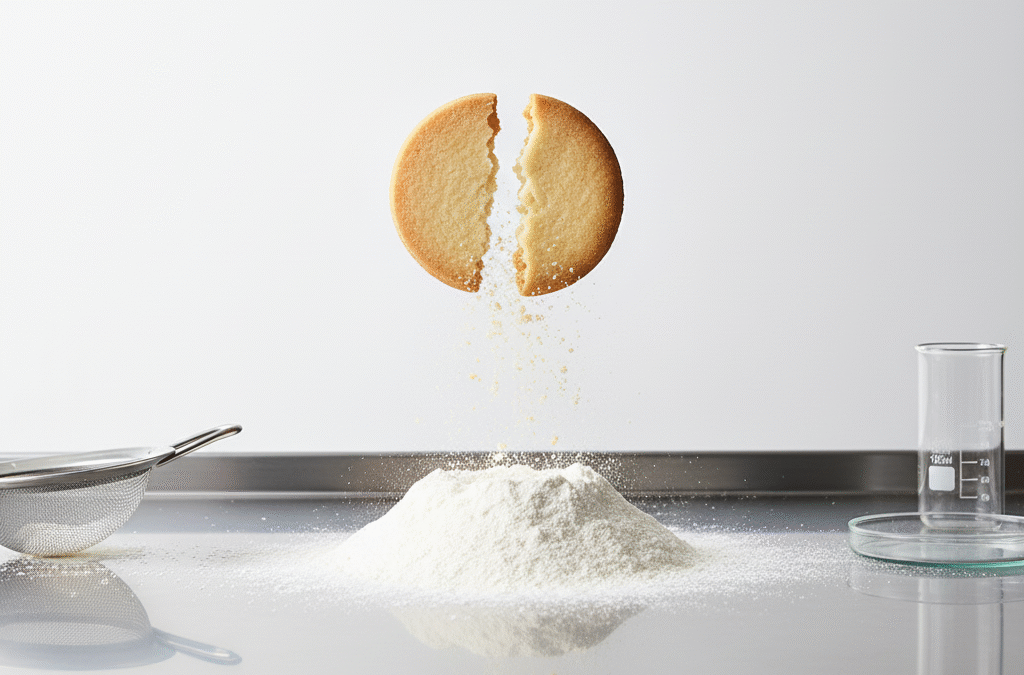INGREDIENTS UNDER THE LENS
The Magnificent Weakness of Flour: The Science of Perfect Shortcrust Pastry
By Katia Oldani, Biologist Pastry Chef
Welcome to my column, “Ingredients Under the Lens.” Today, we’re tackling a crucial topic: choosing the right flour for shortcrust pastry (the Italian dough known as pasta frolla). We will analyze a concept that is a true paradox: in a world obsessed with strength, we’ll see how the key to perfection lies in the exact opposite—the magnificent weakness of flour.
Yes, you read that correctly. We will analyze at a molecular level why the greatest ally of a tender, melt-in-your-mouth cookie or tart crust is its intrinsic inability to create a strong structure. It’s time to shift our perspective and celebrate the elegance of fragility.
Molecular Analysis: The Gluten Network and Its Antithesis
To understand weakness, we must first define its opposite. The “strength” of a flour (expressed by the “W” value in Europe, or more commonly by protein percentage) is a measure of its proteins’—gliadin and glutenin—ability to form a viscoelastic complex called gluten when mixed with water and mechanical force.
This three-dimensional network is the backbone of high-rising baked goods; its tenacity and elasticity allow it to trap fermentation gases, giving bread and pizza their volume and soft crumb.
In shortcrust pastry, however, this phenomenon is our antagonist. The goal is not to build, but to preserve the absence of structural bonds. A shortcrust dough is a chemical-physical system dominated by fats (butter) and sugars.
- The Role of Lipids: Butter molecules act as protein waterproofers. They physically coat the flour particles, preventing the proteins from properly hydrating and bonding to form gluten. It’s a strategic act of sabotage.
- The Role of Sugars: Sugar is hygroscopic and competes with proteins for the available water in the system, further dehydrating it and hindering the development of any elastic bonds.
Choosing a “weak” or low-protein flour—typically with a protein content below 10% (and a W value < 170)—means embracing this strategy from the start, using a base with an inherently low potential for gluten formation.
How to Choose the Right Flour for Tender Pastry
Selecting a low-protein flour is not a minor detail; it is the theoretical foundation for achieving tenderness (what Italians call friabilità). This quality, which we perceive as a “melt-in-your-mouth” texture, has a precise physical explanation: it is the result of a “short,” unlinked structure that easily collapses under minimal mechanical pressure (a bite).
When a recipe calls for “all-purpose flour,” a discerning professional knows not all flours are created equal. They actively seek out flours labeled as “cake flour,” “pastry flour,” or those with a declared low protein content (generally 7-9%).
The most common mistake is using a strong, high-protein flour (like bread flour) and assuming “flour is flour.” This introduces a variable that works directly against your desired outcome, resulting in a tough, glassy, and shrunken pastry after baking.
The Operating Protocol: Preserving Weakness
This scientific awareness must also guide the mixing process:
- Minimal Mechanical Action: The dough should be worked only as long as necessary to combine the ingredients (using the rubbing-in or sabbiatura method). Over-mixing, even with a low-protein flour, can begin to develop the little gluten that is present.
- Temperature Control: Using cold ingredients further limits bond formation by keeping the fats solid and maximizing their waterproofing effect.
A Biologist Pastry Chef’s Summary
Pastry is an applied science where every ingredient has a precise function. Understanding that strength is not an absolute virtue, but a characteristic to be sought or avoided depending on the goal, marks the transition from a mere follower of recipes to a conscious creator.
The next time you make cookies, you aren’t just mixing. You are orchestrating a complex system whose success is based on an elegant principle: to preserve and celebrate weakness. This is the scientific signature of a technically perfect shortcrust pastry.
Now, it’s your turn. Have you ever fought with a dough that was too elastic? Tell me about your experience in the comments. And if you want to apply this theory, I invite you to try my protocol for Shortcrust Pastry made with this scientific method.
P.S. You will find it in the next “Ingredients Under the Lens” article.
Until the next discovery,
Katia Oldani
Biologist Pastry Chef
Click here and Visit My YouTube Channel
For any information or to get in touch, CLICK HERE
#IngredientsUnderTheLens #BiologistPastryChef #BakingScience #PastryFlour #FlourStrength #FoodScience #KatiaOldani


